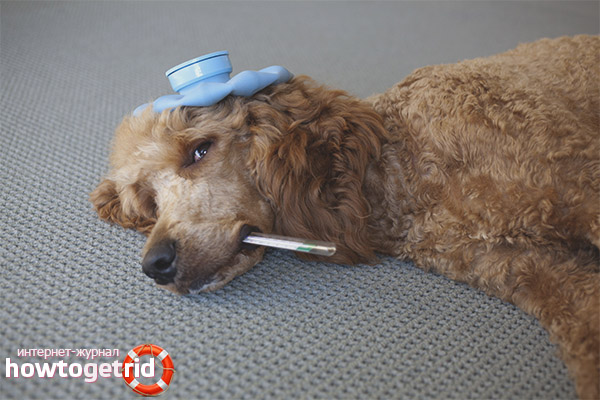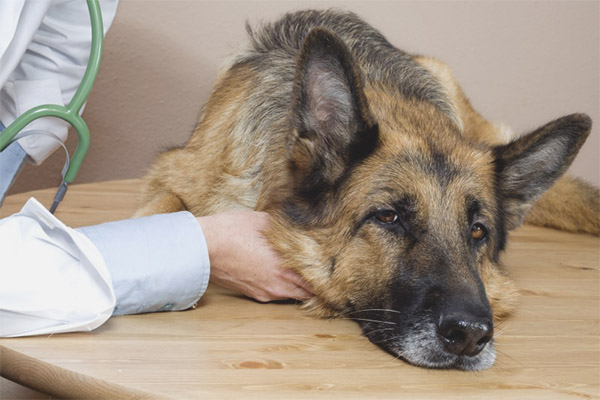The content of the article
Poisoning is called the effects of the penetration of toxic substances into the body. It can happen randomly or purposefully. Unfortunately, dogs are not as discerning as humans. The most dangerous for them are acute poisoning, which is very difficult to proceed and can cause disability or death.
Often, dogs eat everything that comes before their eyes, including completely inedible objects and substances. For this reason, it is the owners of the dogs who are most often to blame for the poisoning.
Causes of Dog Poisoning
Poisonings are deliberate and unintentional. Unintentionally, the animal can poison itself by negligence. Intentional poisoning also happens when the owners or other people use obviously toxic substances to kill the dog.
- Eating a stale meal. Many believe that these animals can eat everything, and their body is able to cope with any inedible substances that are dangerous to humans. However, food that is not suitable for food can cause acute food poisoning with all the ensuing consequences.
- The availability of dogs to household chemicals. Any products of chemical production can provoke a very heavy poisoning from a pet. It can be caused by home care products, cosmetics, various kinds of poisons and household chemicals. Poisons are especially dangerous for the extermination of rodents, insects and parasites.
- Anthelmintics. Substances that are designed to get rid of parasites in the body, with improper dosage and non-compliance with the rules of admission, can cause severe poisoning.
- The use of substandard dry dog food. Outbred yard dogs, whose owners save on high-quality food, most often suffer from it. However, they often give food of unknown production, which are several times cheaper than high-quality ones.
- Walking without supervision on the territory near the house. When self-walking, the dog can eat something that absolutely can not be eaten, for example, spoiled food or vegetables in the summer cottage, which are treated with poisons. In addition, the cause of poisoning can be some poisonous plants and flowers, belladonna, henbane, dope and many others.
Important! In recent years, a movement of activists called doghunters has arisen. The activity of these movements consists in the extermination of stray dogs. For this reason, walking in large cities can end in a tragic way. They kill dogs with special baits with poisons that are scattered in places of walking. Having picked up such bait on the street, the dog can simply die. Recently, many cases of poisoning of domestic animals have been recorded, which are associated precisely with the activities of this movement.
Types of poisoning
Any poisoning in dogs can be caused by food and non-food, as well as external factors.
- Food poisoning occurs subsequently eating poisonous or spoiled food, the shelf life of which has long been out.They begin to develop bacteria, which, when ingested, begin to actively proliferate, affecting all internal organs. They are not as dangerous as chemicals, but they can also be fatal.
- Non-food poisoning can provoke chemicals that are unsuitable for human consumption. This may be household chemicals, poisons, means to combat insects and other pests.
Signs of
The clinical picture depends directly on the substance that has poisoned the animal. Each of them in any particular case may affect the dog's body in different ways. These symptoms include:
- drowsiness, lethargy and apathy;
- the appearance of tremors in the body and limbs, fever;
- fever;
- increased drooling, possibly with blood;
- the occurrence of vomiting and nausea;
- the presence of convulsions and paralysis;
- development of diarrhea;
- increased breathing and acceleration of heart rate, or vice versa;
- abrupt changes in behavior, which are characterized by oppression or overexcitement.
In this case, the symptoms develop suddenly and gradually increase.The condition of the animal worsens, other, more dangerous and severe ones join the first symptoms.
In case of poisoning with rat poison, the feces may contain blood impurities, body temperature rises, pallor of the mucous membranes of the eyes and mouth is observed. The dog has a faster heartbeat, which may be accompanied by periodic whining or outraged barking.
In isoniazid poisoning, the symptoms are somewhat different. The pet has confusion, disorientation, while walking it staggers, begins to lose balance. These symptoms are accompanied by vomiting, drowsiness, the release of foam from the mouth, possibly with bloody impurities, breathing is inhibited, prolonged convulsions are observed, then a state of coma or lethargic sleep occurs.
How to help

When a dog has symptoms of poisoning, you need to take action immediately. Every minute is very important, as poisons quickly spread throughout the body, disrupting its work, thereby aggravating the condition and reducing the possibility of recovery. Gradually, all organs and systems are affected by the action of a toxic substance.
The first thing to do is to neutralize toxic substances contained in the body or the digestive tract. When food poisoning should provoke vomiting with saline: 15 grams of salt mix in a glass with warm water or dilute hydrogen peroxide with water 50 to 50 and give the dog.
For insect bites, you need to find a bite site and invite something very cold there. For example, wrap a piece of ice in a handkerchief and attach it to the affected area. For snake bites, you must urgently take steps to remove the poison from the bite site, then contact your veterinarian. For the period of transportation a cold compress is applied to the diseased area to prevent the spread of poison throughout the body. If the bite is on a limb, a tourniquet can be applied.
If poisonous substances are in contact with the skin, it is necessary to rinse the area with plenty of water. If the poisoning occurs when exposed to vapors with chemical compounds - it is necessary to transport the animal in a well-ventilated place. If the dog is poisoned with gasoline fumes or turpentine - this poisoning may be accompaniedcramps and vomiting. Pet must be given 50 ml of vegetable oil and after 30 minutes a laxative.
If the cause of the poisoning is Isoniazid
- The first thing to do is to give the animal a saline solution, and then any available sorbent. Activated carbon is given at the rate of 1 tablet per 10 kg of body weight.
- Then you must give your pet a sorbent, for example, activated carbon or other similar preparations. “Humans” are quite suitable: Atoxil, White Coal, Enterosgel and others.
- After that apply antidotes, often Pyridoxine.
- The animal is required to give a large amount of drink, water or milk and immediately contact a veterinarian.
Treatment
Poisoning very often becomes the cause of the death of the animal, so measures must be taken urgently.
- In the case of food poisoning, it is necessary to induce vomiting, and then give the dog adsorbents. As a sorbent, you can use activated charcoal, egg protein, magnesia, kaolin. If they are not available, you can use strongly brewed tea, give more milk, use a solution of potassium permanganate.
- To permanently remove toxins from the body, gastric lavage with a probe will be required. If the poisoning happened more than 2 hours ago, the dog is given enemas with water at a temperature of no more than 30 degrees using salt in the proportion of 1 tbsp. l per liter of water.
- Then a complex of medical measures is taken, which are prescribed by a veterinarian after an exact determination of the cause of the poisoning. It depends on what exactly caused the toxic effect on the dog's body. When poisoning with rat poisons, the animal is given antidotes in the form of vitamins and special preparations. Then the solutions of such drugs as Trisol, Glucose Ringer-lokka and others are injected dropwise.
- Along the way, a medicine is prescribed to eliminate the symptoms and improve the general condition; diuretics, iron preparations, and others are prescribed.
However, the first thing to do is to immediately deliver the pet to the veterinary clinic. Only qualified assistance can save the animal from death and prevent possible consequences for its health.
Preventive measures
The possibility of poisoning a dog depends on its upbringing. The owner must teach his pet to the fact that you should not pick up on the street, there are unfamiliar plants and take food from other people. It must be remembered that a properly bred animal that receives a sufficient amount of properly balanced food will in no way select anything inedible.
The following tips will help protect the animal from poisoning:
- During walking you need to look after the animals. In time to remove spoiled food from the house and the territory of the site.
- Take care that chemicals, medicines, poisons are in the reach of the dog.
- Take care of the health of the animal. It is important to diversify the diet with vegetables, cereals, periodically give vitamin-mineral complexes. The amount of food should be sufficient and food should be timely.
- To accustom an animal to a certain diet and food consumption in one particular place, from its own bowl, but in no case from the floor and not from the hands, especially from unauthorized people.
- If in the conditions of the private sector there is a plot where food is grown, you need to ensure that it is sufficiently fenced. Because, one way or another, plants are treated with poisons and other chemicals that can protect the crop from pests and diseases.
Despite the fact that dogs are more resistant than humans, they are also susceptible to poisoning by substances that are toxic to them as well as to humans. At the first suspicion of poisoning, it is necessary to take action as a matter of urgency, otherwise everything can end in a tragic way. Particular attention should be paid to those animals that have the possibility of independent walking. At the first suspicion of poisoning, you must give your pet an adsorbent and deliver it to a veterinary clinic or call a specialist at the house.
Video: first aid for dog poisoning












To send